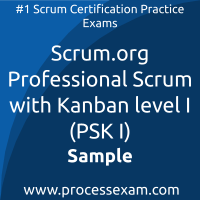 You have to pass the PSK I exam to receive the certification from Scrum.org. To increase the effectiveness of your study and make you familiar with the actual exam pattern, we have prepared this Scrum.org Professional Scrum with Kanban sample questions. Our Sample Scrum.org Professional Scrum with Kanban Practice Exam will give you more insight about both the type and the difficulty level of the questions on the Scrum.org PSK 1 exam.
You have to pass the PSK I exam to receive the certification from Scrum.org. To increase the effectiveness of your study and make you familiar with the actual exam pattern, we have prepared this Scrum.org Professional Scrum with Kanban sample questions. Our Sample Scrum.org Professional Scrum with Kanban Practice Exam will give you more insight about both the type and the difficulty level of the questions on the Scrum.org PSK 1 exam.
However, we are strongly recommending practice with our Premium Scrum.org Certified Professional Scrum with Kanban (PSK I) Practice Exam to achieve the best score in your actual Scrum.org PSK I Exam. The premium practice exam questions are more comprehensive, exam oriented, scenario-based and exact match of Scrum.org Professional Scrum with Kanban exam questions.
Scrum.org Professional Scrum with Kanban Sample Questions:
01. What does the Work Item Aging chart show?
a) How many sprints ago has the team revised their WIP limits.
b) For each item on the Kanban board how long ago has it been pulled into WIP.
c) The approximate average age of work in process in the team.
d) How many days has the team worked without breaching the WIP limits.
02. A Scrum Team Member has got 10 tasks that were completed on average in 12 days. Which metric of flow is being described here?
a) Work item age.
b) WIP.
c) Service Level Expectation.
d) Work Item Age.
e) Cycle time.
f) Throughput.
03. Work Item Age is a leading indicator only relevant for:
(Choose all that apply)
a) Non-finished items Only.
b) Items which have not started.
c) The length of the Scrum Team’s feedback loop for in progress item.
d) All the Work Items in the workqueue.
04. What does one see in a typical Cumulative Flow Diagram?
(Choose all that Apply)
a) Cycle Time. (and Not Average Cycle Time).
b) Stage of Workflow.
c) WIP items.
d) Total Number of work Items.
05. In a newly formed Scrum Team, Developers wants to involve the Product Owner in their Sprint flow. The Product Owners role will be to review and accept a story during the Sprint before it goes through testing.
In such a situation who owns the workflow and specifically the WIP limits?
a) The Product Owner.
b) The Scrum Master.
c) The Scrum Team.
d) The Development Team.
06. Calculating which metrics of flows requires the Scrum Team to track the start date of each item?
(Choose all that Apply)
a) Throughput
b) Work Item Age.
c) Cycle Time.
d) Work in Progress (WIP).
07. The Sprint Goal needs to be corrected. Who should be present?
a) Entire Scrum Team.
b) CEO of the Company.
c) Product Owner and Developers.
d) Product Owner Only.
08. Who is responsibility to ensure the continuous, proactive, active, and reactive management of work items in progress?
a) The Scrum Team.
b) The Scrum Master.
c) The Product Owner.
d) Developers.
09. You’ve got 100 tasks that were completed in 50 days. If 50 of them were finished in 7 days or less, while all the others took longer, you’ve got 50 percent chance to finish any future task within 7 days. This is an example of:
a) Cycle time.
b) Throughput.
c) Work Item Age.
d) WIP.
10. During Daily Sprints, the Scrum Guide suggests that the Developers explain what they did yesterday, what they are focusing on today, and what their impediments are.
Kanban teams typically focuses:
a) On the Project plan.
b) On the flow of work instead of the people doing the work.
c) On the People doing the work.
d) On the Work policies only.
Answers:
Question: 01
Answer: b |
Question: 02
Answer: e |
Question: 03
Answer: a, c |
Question: 04
Answer: b, c, d |
Question: 05
Answer: c |
Question: 06
Answer: b, c |
Question: 07
Answer: a |
Question: 08
Answer: a |
Question: 09
Answer: a |
Question: 10
Answer: b |
If you find any errors or typos in Scrum.org Certified Professional Scrum with Kanban (PSK I) sample question-answers or online Scrum.org PSK 1 practice exam, please report them to us on feedback@processexam.com
 You have to pass the PSK I exam to receive the certification from Scrum.org. To increase the effectiveness of your study and make you familiar with the actual exam pattern, we have prepared this Scrum.org Professional Scrum with Kanban sample questions. Our Sample Scrum.org Professional Scrum with Kanban Practice Exam will give you more insight about both the type and the difficulty level of the questions on the Scrum.org PSK 1 exam.
You have to pass the PSK I exam to receive the certification from Scrum.org. To increase the effectiveness of your study and make you familiar with the actual exam pattern, we have prepared this Scrum.org Professional Scrum with Kanban sample questions. Our Sample Scrum.org Professional Scrum with Kanban Practice Exam will give you more insight about both the type and the difficulty level of the questions on the Scrum.org PSK 1 exam.